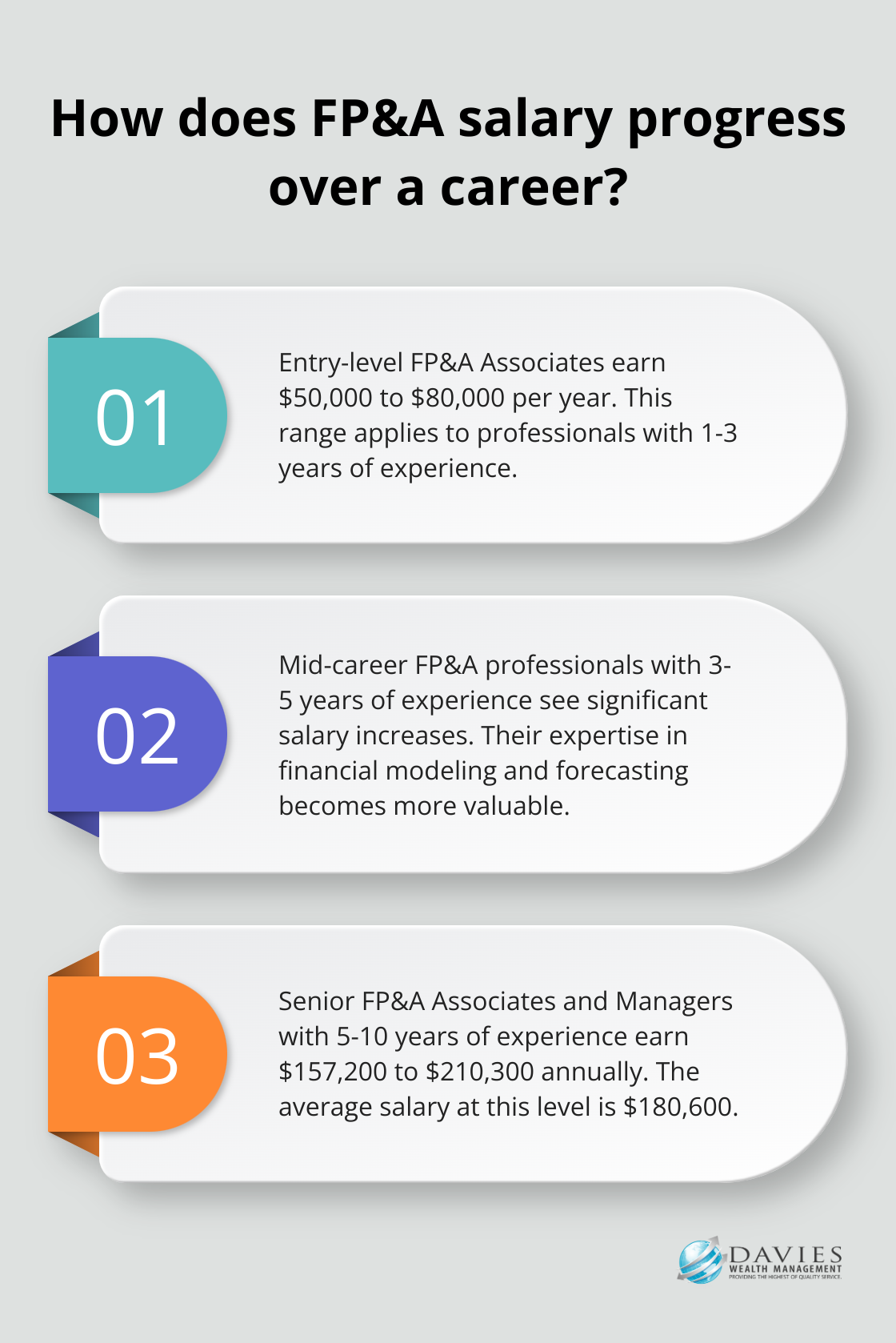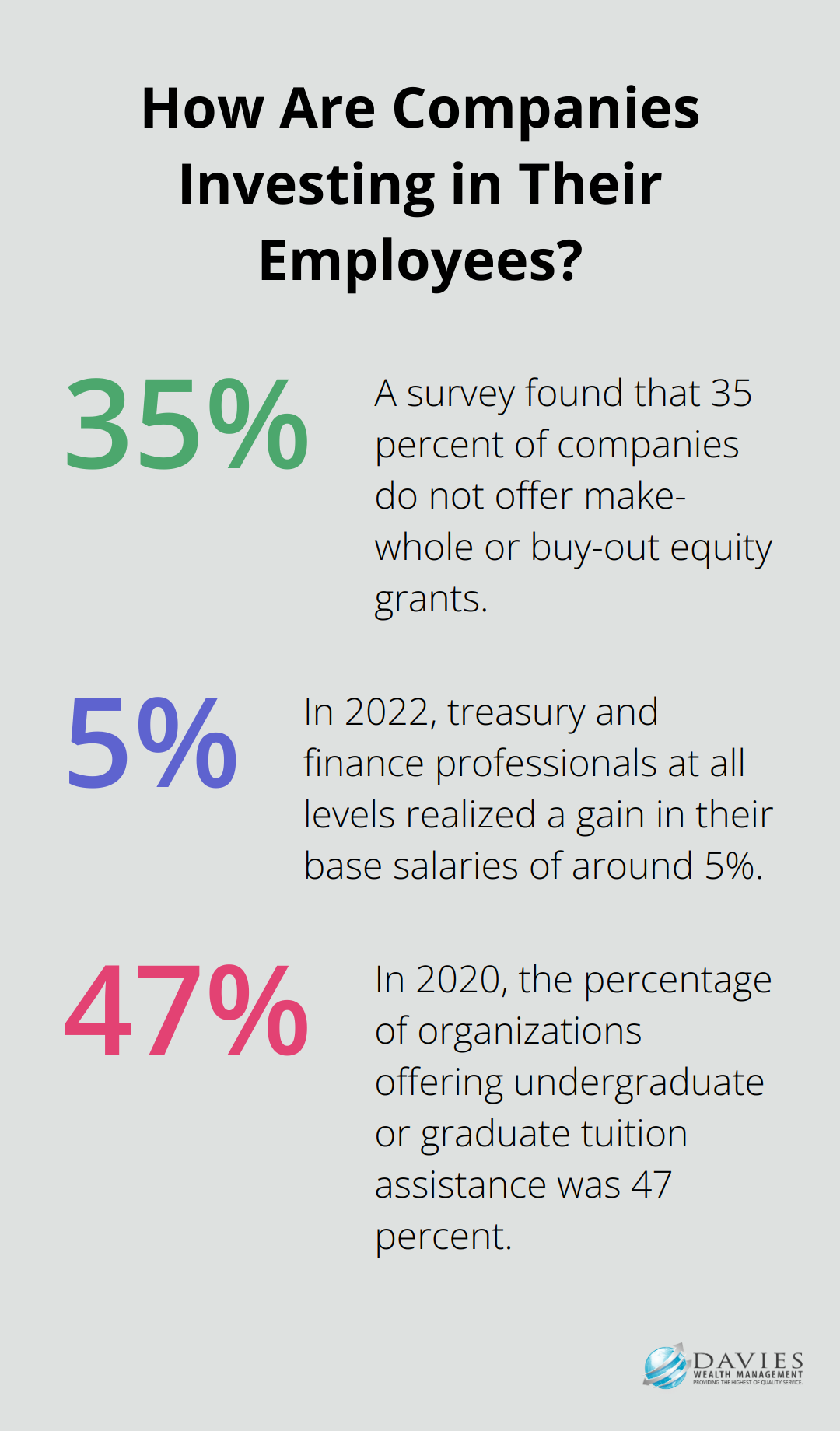At Davies Wealth Management, we understand the importance of informed career decisions in the financial sector. The role of a Financial Planning and Analysis (FP&A) Associate is pivotal in many organizations, offering a blend of analytical skills and strategic insight.
In this guide, we’ll explore the Financial Planning and Analysis Associate salary landscape, providing you with valuable information to navigate your career path. From entry-level expectations to senior-level compensation, we’ll cover the factors that influence FP&A Associate salaries and the additional benefits that often accompany these positions.
What Does an FP&A Associate Do?
Core Responsibilities
Financial Planning and Analysis (FP&A) Associates shape an organization’s financial strategy. These professionals create financial statements, analyze profit margins, budget, and forecast future financial performance. They collaborate with various departments to collect data, identify trends, and provide insights that drive business decisions. An FP&A Associate might analyze the financial impact of a new product launch or assess the viability of entering a new market.
Skills and Qualifications
To excel in this role, FP&A Associates need a strong foundation in finance and accounting. Most positions require at least a bachelor’s degree in finance, accounting, or a related field. Many employers prefer candidates with advanced degrees (like an MBA) or relevant certifications (such as CFA or CPA).

Technical skills are paramount. Proficiency in Excel is a must, and knowledge of financial modeling software and data visualization tools is increasingly important. A recent survey by the Association for Financial Professionals found that understanding the data lifecycle, the ability to interpret statistics, use BI tools, and apply relevant programming are critical skills for FP&A professionals.
Soft skills are equally important. FP&A Associates must effectively communicate complex financial information to non-financial stakeholders. They also need strong analytical and problem-solving skills to interpret data and provide actionable recommendations.
Career Growth Opportunities
The FP&A field offers significant growth potential. Many professionals start as Associates and progress to Senior Analyst, Manager, and even Director or VP roles. According to Glassdoor, the average salary for an FP&A Manager is $124,676, while Directors can earn upwards of $180,600.
Some FP&A professionals also transition into broader finance roles or even C-suite positions. However, a recent study found that only 12 percent of CFOs say their company has a framework for succession planning, indicating potential opportunities for improvement in this area.
Industry-Specific Applications
FP&A skills prove valuable across various industries. In the sports industry, for example, FP&A professionals help manage the unique financial challenges athletes face (such as fluctuating incomes and short career spans). They forecast and analyze complex financial scenarios to provide tailored financial strategies for athletes.
As we move forward, let’s explore the salary ranges for FP&A Associates at different career stages and the factors that influence compensation in this dynamic field.
FP&A Associate Salary Ranges: A Comprehensive Guide
Financial Planning and Analysis (FP&A) Associate salaries typically range from $50,000 to $80,000 per year in the United States. Understanding these salary ranges is essential for job seekers and employers in the financial sector.
Entry-Level Salaries
For those starting their FP&A careers, the average salary in the United States ranges from $50,000 to $80,000 per year. This range reflects the competitive nature of the field and the high value placed on analytical skills from the outset. Entry-level positions typically require 1-3 years of experience, and those with relevant internships or certifications may command salaries at the higher end of this range.
Mid-Career Earnings
As FP&A Associates gain experience and take on more responsibilities, their earning potential increases significantly. Mid-career professionals (often with 3-5 years of experience) can expect salaries to increase accordingly. This jump in compensation reflects the increased value of their expertise in financial modeling, forecasting, and strategic decision-making.
Senior-Level Compensation
Senior FP&A Associates and Managers with 5-10 years of experience see another substantial increase in their earning potential. In the United States, FP&A directors typically earn an average salary ranging from $157,200 to $210,300 per year, with an average of $180,600. At this level, professionals often lead teams, drive financial strategy, and directly influence high-level business decisions.
Factors Influencing Salaries
Several factors can significantly impact FP&A Associate salaries:
- Location: Major financial hubs like New York, San Francisco, and Chicago tend to offer higher salaries to offset the higher cost of living.
- Industry: Certain industries, such as technology and pharmaceuticals, often offer higher compensation for FP&A roles.
- Company Size: Larger companies typically offer higher salaries and more comprehensive benefits packages. However, smaller firms may offer more rapid advancement opportunities and potentially higher long-term earning potential.
- Education and Certifications: Advanced degrees (like MBAs) or certifications (such as CFA or CPA) can boost earning potential. According to the 2024 AFP Compensation and Benefits Survey Report, treasury and finance professionals realized a 4.4% increase in their 2023 base salaries.

Understanding these salary ranges and influencing factors helps both job seekers and employers in the FP&A field make informed decisions. The next section will explore the additional compensation and benefits that often accompany FP&A Associate positions, providing a more complete picture of the total compensation package in this dynamic field.
Beyond Base Salary: Comprehensive Compensation for FP&A Associates
Financial Planning and Analysis (FP&A) Associates often receive compensation packages that extend well beyond their base salaries. These additional benefits can significantly boost overall earnings and provide valuable long-term financial security. This chapter explores the various components that make up a comprehensive FP&A compensation package.
Performance-Based Incentives
Many companies offer performance-based bonuses to FP&A Associates. These bonuses typically link to individual, team, or company-wide performance metrics. In 2022, treasury and finance professionals at all levels realized a gain in their base salaries of around 5%, the highest increase in a decade. Some organizations also offer profit-sharing plans, which allow employees to benefit directly from the company’s financial success.
Equity Compensation
Stock options and restricted stock units (RSUs) have become increasingly common in FP&A compensation packages, especially in tech and startup environments. These equity-based incentives align employee interests with company performance and can provide substantial long-term value. A survey found that 35 percent of companies do not offer make-whole or buy-out equity grants, and 48 percent offer them on an exception basis only.
Comprehensive Benefits Package
Health insurance and retirement plans form the cornerstone of most FP&A benefit packages. Many employers offer high-quality health insurance plans (including dental and vision coverage). 401(k) plans with employer matching contributions are particularly common, with some companies matching up to 6% of an employee’s salary.
Professional Development Opportunities
Companies invest in employee growth to benefit both FP&A Associates and their employers. Many organizations offer tuition reimbursement programs for relevant advanced degrees or professional certifications. In 2020, the percentage of organizations offering undergraduate or graduate tuition assistance was 47 percent, down 9 percentage points. Additionally, companies often provide budgets for attending industry conferences, workshops, and training sessions to keep their FP&A teams at the forefront of industry trends and best practices.
Work-Life Balance Perks
Progressive companies recognize the importance of work-life balance in attracting and retaining top FP&A talent. These perks may include flexible work hours, remote work options, generous paid time off policies, and wellness programs. Some organizations even offer sabbaticals or extended leave options for long-term employees, allowing them to recharge and pursue personal interests without jeopardizing their career progression.

Final Thoughts
The financial planning and analysis associate salary landscape offers significant potential for growth and reward. Entry-level FP&A associates can expect salaries ranging from $50,000 to $80,000 annually, with the potential to reach six-figure incomes as they progress to senior roles. Factors such as location, industry, company size, and individual qualifications play important roles in determining compensation.

The career outlook for FP&A associates remains strong, with increasing demand for professionals who can provide data-driven insights to guide strategic decision-making. As businesses continue to prioritize financial planning and analysis, opportunities for advancement and specialization within the field will likely expand. When negotiating compensation packages, it’s essential to consider the total value proposition beyond just the base salary (performance bonuses, equity compensation, comprehensive benefits, and professional development opportunities can significantly enhance the overall package).
At Davies Wealth Management, we understand the importance of financial planning not just for businesses, but for individuals as well. Our expertise in managing the unique financial challenges faced by professional athletes and other high-net-worth individuals translates into valuable insights for those navigating their own financial planning and analysis careers. We encourage you to explore how our services can support your financial goals and career aspirations in the dynamic field of FP&A.



Leave a Reply